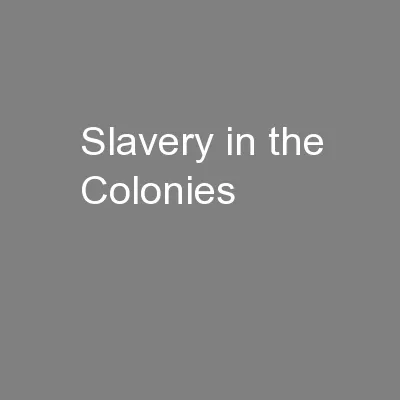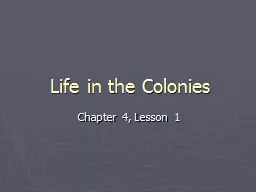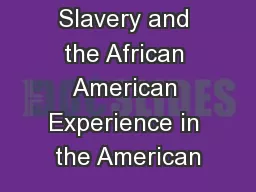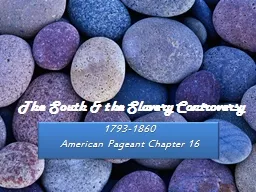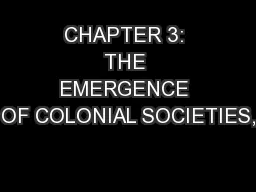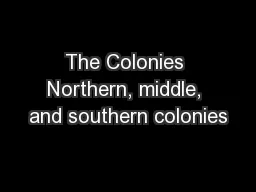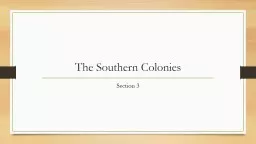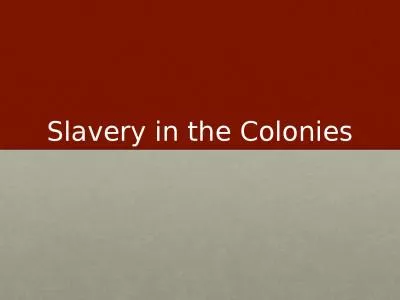PPT-Slavery in the Colonies
Author : kittie-lecroy | Published Date : 2016-10-16
Big Ideas of the Lesson The English enslaved Africans and forced them to work in the colonies Slavery had terrible effects on people and cultures of Africa Although
Presentation Embed Code
Download Presentation
Download Presentation The PPT/PDF document "Slavery in the Colonies" is the property of its rightful owner. Permission is granted to download and print the materials on this website for personal, non-commercial use only, and to display it on your personal computer provided you do not modify the materials and that you retain all copyright notices contained in the materials. By downloading content from our website, you accept the terms of this agreement.
Slavery in the Colonies: Transcript
Big Ideas of the Lesson The English enslaved Africans and forced them to work in the colonies Slavery had terrible effects on people and cultures of Africa Although a majority of the enslaved Africans lived in the Southern Colonies they were part of the population of each of the 13 colonies . Slavery Grievance. Thomas Jefferson was born to a slave-owning family and he . himself owned . slaves. As chairman of the committee that drafted . the Declaration . of Independence, Jefferson wrote a . Chapter . 4. , . Lesson . 1. Intro. An Englishman by the name of Andrew Burnaby traveled through the American Colonies in 1760.. He observed the lifestyle of the colonist and claimed that he could not see the colonist uniting for a purpose.. Crispus. Attucks in the Mob at the “Boston Massacre,” 1770. Phillis. Wheatley, Boston Slave and Published Poet. Slavery and Slave Revolt as a Cause of the American Revolution. Centrality of Slavery to British North America. 4.1 The New England Colonies . Boston was the busiest town in the Massachusetts Bay Colony. Religion played a crucial part in the development of the N.E colonies. Maine (part of MA), New Hampshire, Massachusetts, Connecticut, Rhode Island. 1793-1860. American Pageant Chapter 16. “Cotton is King!”. King Cotton. Cotton Gin—revives slavery. South & others profited. ½ of American exports after 1840. Produced more than ½ world’s supply. 1625-1700. AP FOCUS. Similarities and differences amongst the colonial regions, focusing on:. Geography. Politics. Economics. Religion. Social structure. Religious toleration and separation of church and state. Create your new colony. You have found a new colony-congratulations! Now you have some decisions to make:. Economy-How will you make $$?. Government-How will it be structured?. Social/cultural aspects-what are they? What is life like? Are there social classes?. The English enslaved Africans and forced them to work in the colonies.. Slavery had terrible effects on people and cultures of Africa. Although a majority of the enslaved Africans lived in the Southern Colonies, they were part of the population of each of the 13 colonies. . - Frederick Douglass. Frederick Douglass. “I expose slavery in this country, because to expose it is to kill it. Slavery is one of those monsters of darkness to whom the light of truth is death.” . Mason- . Dixon Line . Divided Southern Colonies from the rest of the . colonies. Between Pennsylvania and Maryland. 244 miles long. Named after Charles Mason and Jeremiah Dixon. They surveyed the land and created the “line.”. La gamme de thé MORPHEE vise toute générations recherchant le sommeil paisible tant désiré et non procuré par tout types de médicaments. Essentiellement composé de feuille de morphine, ce thé vous assurera d’un rétablissement digne d’un voyage sur . WHO? English, Persecuted Christians, Merchants, Shipping, a few Slaves and Indentured Servants.. Pilgrims, Puritans. SUBSISTENCE? Subsistence farms, fishermen, ship builders, merchants. TRADITIONAL PURITAIN DRESS. Topic #7 Development of Colonial Slavery How did European slavery of Africans first develop? Portuguese fort named Elmina (“the mine”) Portuguese first began using slaves on the sugar plantations established on Sao Tome and Principe Slavery existed in . the United States from the early 17th century until 1865, when . Congress. enacted the . Thirteenth Amendment. shortly after the Union victory over the Confederacy in the . Civil War.
Download Document
Here is the link to download the presentation.
"Slavery in the Colonies"The content belongs to its owner. You may download and print it for personal use, without modification, and keep all copyright notices. By downloading, you agree to these terms.
Related Documents

